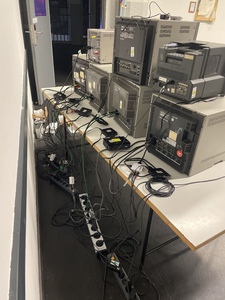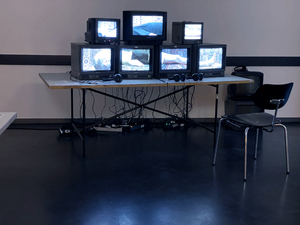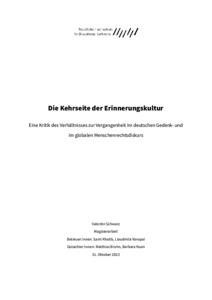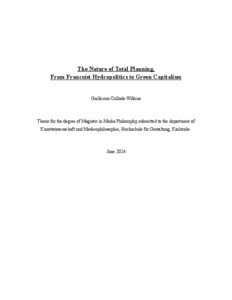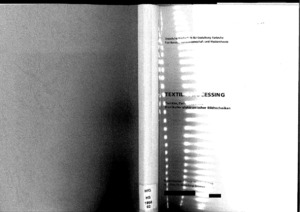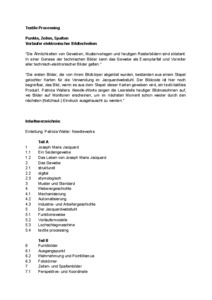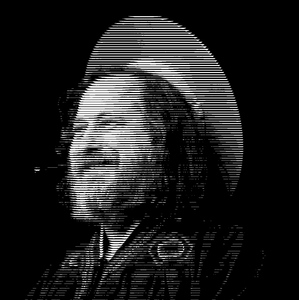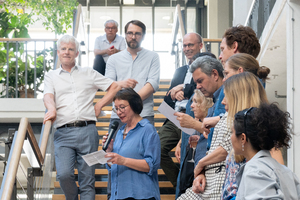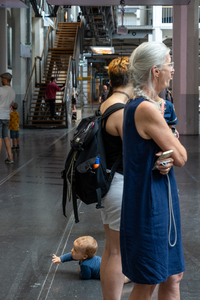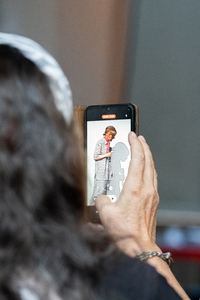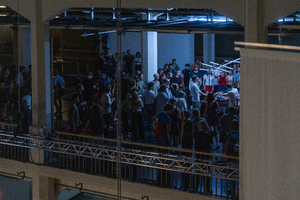"Kunstwissenschaft und Medienphilosophie"
| Term | Kunstwissenschaft und Medienphilosophie |
| Metakey | Program of Study (institution:program_of_study) |
| Type | Keyword |
| Vocabulary | HfG |
95 Items
- Page 1 of 8
Who Cares?
- Title
- Who Cares?
- Title (en)
- Who cares?
- Subtitle
- Digitale Sozialität, Infrastrukturen der Fürsorge und konviviale Technologien
- Subtitle of the project/work (en)
- Digital sociality, care infrastructure and convivial technology
- Author
- Description (de)
- Die Hackerkultur verbindet Theorie und Praxis (nach hand-on Prinzipien) und einen neuen Ansatz für Kulturmaterialien (»information wants to be free«), der nicht nur eine andere Epistemologie, sondern auch einen neuen politischen Diskurs über Digitalität, Geräte und Menschen impliziert. Das Verhältnis zwischen Technik und Politik dieser Gruppe wird im ersten Kapitel analysiert: Zuerst wird die Entstehung proprietärer Software betrachtet, dann die Unterschiede zwischen Open Source und freier Software, und wie im letzten die Privateigentum und die soziale Beziehung zwischen Programmen, Benutzern und Entwicklern radikal in Frage gestellt werden. Später wird diese Beziehung anhand von Hanna Arendts _Die conditio humana_ in Bezug auf Arbeit, Herstellen und Handlen, Notwendigkeit und Freiheit, die die Bedingungen für Politik schaffen, weiter diskutiert. Im zweiten Kapitel wird das Konzept der Konvivialität (Ivan Illich) vorgestellt und diskutiert. Diese Idee wird später in der Wartung als infrastrukturelle Vorsorge weiterentwickelt und als ein zentrales Element digitaler Technologien vorgeschlagen, das weiter diskutiert werden sollte. Diese Konstellation des Denkens und Handelns, des Spielens und Lernens, des Experimentierens und der Übernahme von Verantwortung sowie der Politik und der sozialen Beziehungen sollte in der Technologiedebatte eine wichtige Rolle spielen.
- Description (en)
- Hacker culture connects theory and praxis (following hand-on principles) and a new approach to culture materials (»information wants to be free«), that implies not only a different epistemology, but also a new political discourse on digitality, devices, and people. The relation between technic and politic of this group is analyzed in the first chapter: first focusing on the emergence of proprietary software; then considering the differences between open source and free software, the last one challenging radically the notion of private property and the social relation among programs, users, and developers. Later on, reading Hanna Arendts "The Human condition", the relation will be further discussed in terms of labor, work and action, necessity and freedom, which establish the conditions for politics. In the second chapter, the concept of conviviality (Ivan Illich) is introduced and discussed. This idea is later developed in maintenance as infrastructural care and proposed as a central element of digital technologies that should be further discussed. This constellation of thinking and acting, playing and learning, experimenting and taking responsibility, as well as politics and social relations should play a prominent role in the debate about technology.
- Type of project / creative work
- Keywords
- Date
- 30.09.2023
- Language
- Title
- Who Cares?
- Title (en)
- Who Cares? [Main Text]
- Copyright Notice
- Víctor Fancelli Capdevila
- Legal protection / Licence
- Permission usage HfG
- Media creator
- Description of media
- Text in PDF, Version 1.0
- Description of media (en)
- Text in PDF, Version 1.0
- Projektleiter/in
- Semester
- Program of Study
- Type of graduation project
- Imported on
- 30.11.2023
- Parent sets
- 1
Videowelt und fraktale Entspannung - Rückseite der Installation
- Title
- Videowelt und fraktale Entspannung - Rückseite der Installation
- Author
- Category
- Type of project / creative work
- Date
- 07.2023
- Duration
- 15:30
- Title
- Videowelt und fraktale Entspannung - Rückseite der Installation
- Copyright Notice
- © ewa wasilewska
- Legal protection / Licence
- Permission usage HfG
- Media creator
- Relationship/function
- Description of media
- Rückseite der Installation; mehrere Elementen angeschlossen an die „Maschine“ der Selbstreferenz: HDMI-Analog Konvertern, Android Media Players, DC 5V Stromversorgungsgeräte
- Program of Study
- Imported on
- 16.12.2024
- Parent sets
- 0
Videowelt und fraktale Entspannung
- Title
- Videowelt und fraktale Entspannung
- Author
- Description (de)
- In seinem Text „Videowelt und fraktales Subjekt,“ beschreibt Baudrillard ein Subjekt der digitalen Ära, das danach trachtet, „sich selber in seinen Bruchstücken anzugleichen“ und anstatt nach seinem vollkommenen Idealbild, sehnt es sich nach der „Formel einer endlosen genetischen Reproduktion“ (Baudrillard 1989). Technologische Reduplikationen und Erscheinungsweisen des Körpers formen das Konzept des neuen Selbst. „Es geht heute nicht einmal mehr darum, einen Körper zu haben, sondern an seinen Körper angeschlossen (connected) zu sein.“
"Videowelt und fraktale Entspannung" ist als eine Mehrkanal-Installation, die sich auf das Konzept des fraktalen Körpers nach Baudrillard und der Interpassivität nach Pfaller stützt. Sieben Bildschirme zeigen die Verlängerung des menschlichen Körpers, während ein beauftragter Bot ein ungezwungenes Entspannungsprogramm durchführt. Basierend auf der progressiven Muskelentspannung nach Edmund Jacobson ermöglicht die Installation den Betrachter:innen, an der angeleiteten Choreografie teilzuhaben und so die Verbundenheit des Selbst mit der Technik zu erfahren. So ist sie ironisch als eine interpassive ‘Oase der Entspannung‘ konzipiert.
- In seinem Text „Videowelt und fraktales Subjekt,“ beschreibt Baudrillard ein Subjekt der digitalen Ära, das danach trachtet, „sich selber in seinen Bruchstücken anzugleichen“ und anstatt nach seinem vollkommenen Idealbild, sehnt es sich nach der „Formel einer endlosen genetischen Reproduktion“ (Baudrillard 1989). Technologische Reduplikationen und Erscheinungsweisen des Körpers formen das Konzept des neuen Selbst. „Es geht heute nicht einmal mehr darum, einen Körper zu haben, sondern an seinen Körper angeschlossen (connected) zu sein.“
- Description (en)
- In his text "Video World and Fractal Subject," Baudrillard describes a subject of the digital era that strives to "align itself with its own fragments." Rather than aspiring to its perfect ideal image, it yearns for the "formula of an endless genetic reproduction" (Baudrillard 1989). Technological reduplications and manifestations of the body shape the concept of the new self. "Today, it is no longer even about having a body, but about being connected to one's body."
"Video World and Fractal Relaxation" is a multi-channel installation that draws on Baudrillard's concept of the fractal body and Pfaller's theory of interpassivity. Seven screens depict the extension of the human body while a programmed bot conducts a casual relaxation routine. Based on Edmund Jacobson's progressive muscle relaxation, the installation allows viewers to participate in the guided choreography, offering them an experience of the self's connection with technology. It is ironically designed as an interpassive "oasis of relaxation."
- In his text "Video World and Fractal Subject," Baudrillard describes a subject of the digital era that strives to "align itself with its own fragments." Rather than aspiring to its perfect ideal image, it yearns for the "formula of an endless genetic reproduction" (Baudrillard 1989). Technological reduplications and manifestations of the body shape the concept of the new self. "Today, it is no longer even about having a body, but about being connected to one's body."
- Category
- Type of project / creative work
- Keywords
- Date
- 07.2023
- Contributors
- Language
- Material
- Duration
- 15:30
- Location: institution
- Location
- R. 112
- City
- Title
- Videowelt und fraktale Entspannung
- Copyright Notice
- © ewa wasilewska
- Permission usage HfG
- Media creator
- Description of media
- Mehrkanal-Installation 15’30’’
- Description of media (en)
- Multi-channel installation, 15'30''
- Program of Study
- Imported on
- 16.12.2024
- Parent sets
- 0
Titelblatt zu "Die Kehrseite der Erinnerungskultur"
- Title
- Titelblatt zu "Die Kehrseite der Erinnerungskultur"
- Author
- Category
- Type of project / creative work
- Keywords
- Date
- 31.10.2023
- Remarks
- Eine kondensierte Fassung des Textes wurde von "Umbau" veröffentlicht: https://umbau.hfg-karlsruhe.de/posts/die-kehrseite…
- Title
- Titelblatt zu "Die Kehrseite der Erinnerungskultur"
- Title (en)
- Cover sheet "The Other Side of Erinnerungskultur"
- Copyright Notice
- © Valentin Schwarz
- Permission usage HfG
- Media creator
- Relationship/function
- Description of media
- In dieser Arbeit setze ich mich mit unterschiedlichen Geschichtsbegriffen auseinander. Dafür dienen mir die Diskussionen um die deutsche Erinnerungskultur als Einstiegspunkt. Das Ziel ist es allerdings nicht, unmittelbar in die polarisierte Debatte einzugreifen. Stattdessen richtet sich der Fokus auf das ideologische Fundament, das verschiedenen Formen, mit der eigenen Geschichte umzugehen, zugrunde liegt. Den theoretischen roten Faden bildet das Werk "After Evil" des Philosophen Robert Meister. Darin kritisiert er die Haltung, die Vergangenheit zwar als schlimm zu verurteilen, aber gleichzeitig auch als abgetrennt von der Gegenwart zu betrachten. Herausgearbeitet werden die Argumente unter anderem anhand von Filmen von Alexander Kluge und Harun Farocki
- Description of media (en)
- In this work, I examine different concepts of history. The discussions surrounding the German culture of remembrance serve as my starting point. However, the aim is not to intervene directly in the polarized debate. Instead, the focus is on the ideological foundations that underlie different ways of dealing with one's own history. The work “After Evil” by philosopher Robert Meister forms the theoretical leitmotif. In it, he criticizes the position of condemning the past as evil, but treating it at the same as something that is separated from the present. The arguments are elaborated on the basis of films by Alexander Kluge and Harun Farocki, among others.
- Projektleiter/in
- Semester
- Program of Study
- Type of graduation project
- Imported on
- 15.06.2024
- Parent sets
- 1
The Nature of Total Planning, From Francoist Hydropolitics to Green Capitalism
- Title
- The Nature of Total Planning, From Francoist Hydropolitics to Green Capitalism
- Author
- Description (de)
- Magisterarbeit in Medienphilosophie
- Description (en)
- Thesis for the degree of Magister in Media Philosophy
- Category
- Keywords
- Date
- 06.06.2024
- Language
- Location: institution
- Country
- Title
- The Nature of Total Planning, From Francoist Hydropolitics to Green Capitalism
- Title (en)
- The Nature of Total Planning, From Francoist Hydropolitics to Green Capitalism
- Copyright Notice
- © Guillermo Collado Wilkins
- Legal protection / Licence
- Permission usage HfG
- Media creator
- Description of media (en)
- This paper provides a critical examination of ecological planning based on the continuities that it displays across seemingly disparate political projects and historical periods. In order to do so, it draws on the small rural valley of La Bizkaia in Navarre, Spain. It produces an environmental history of the valley through a detailed study of its hydro-forestry resources, periodising such history according to a materialist reading of its ‘metabolic regimes’. That is to say, through the particular configurations between the natural and social orders that dictate life in La Bizkaia.
Initially, the study introduces the valley’s natural characteristics and its property structure, laying the foundations upon which the rest of this paper sits. Subsequently, it undertakes a detailed investigation of Francoist interventions in the 1940s-60s; a massive monoculture of pine trees was planted by the Francoist Forestry Council, which radically undermined La Bizkaia’s natural systems and depopulated it. This paper thus analyses the planning logic behind this natural intervention which, borrowing a term from one of its draftsmen, is named ‘total planning’.
The thesis then explores contemporary management of the valley by the Government of Navarre, which has maintained ownership until this day, aligning its plans with the international protocols and standards characteristic of green capitalism. By looking at projects undertaken in the valley for nature conservation and climate change adaptation, which receive funding from the European Union, this research reveals the continuities between Francoist policies and green capitalism, and how both operate under the logic of Total Planning. Under this planning logic, they both fail to accommodate the unpredictability of political conflict and natural systems.
Planning thus serves as a lens to explore the political and epistemological dimensions of ecological thought, placing a materialist reading of a small case study into the broader context of contemporary ecological intervention.
- This paper provides a critical examination of ecological planning based on the continuities that it displays across seemingly disparate political projects and historical periods. In order to do so, it draws on the small rural valley of La Bizkaia in Navarre, Spain. It produces an environmental history of the valley through a detailed study of its hydro-forestry resources, periodising such history according to a materialist reading of its ‘metabolic regimes’. That is to say, through the particular configurations between the natural and social orders that dictate life in La Bizkaia.
- Alternative text (de)
- Vollständiger Text der Magisterarbeit
- Alternative text (en)
- Complete text of the Magisterarbeit
- Projektleiter/in
- Semester
- Program of Study
- Type of graduation project
- Imported on
- 22.10.2024
- Parent sets
- 1
Textile Processing Deckblatt
- Title
- Textile Processing Deckblatt
- Author
- Description (de)
- „Die Ähnlichkeiten von Geweben, Mustervorlagen und heutigen Rasterbildern sind eklatant. In einer Genese der technischen Bilder kann das Gewebe als Exemplarfall und Vorreiter aller technisch-elektronischer Bilder gelten.”
„Die ersten Bilder, die von ihrem Bildkörper abgelöst wurden, bestanden aus einem Stapel gelochter Karten für die Verwendung im Jacquardwebstuhl. Der Bildcode ist hier noch begreifbar, das Bild, wenn es aus dem Stapel dieser Karten gewoben wird, ein textil-taktiles Produkt. Patricia Wallers Needle-Works zeigen die Leerstelle heutiger Bildmaschinen auf, wo Bilder auf Monitoren erscheinen, um im nächsten Moment schon wieder durch den nächsten (Netzhaut-) Eindruck ausgetauscht zu werden.”
- „Die Ähnlichkeiten von Geweben, Mustervorlagen und heutigen Rasterbildern sind eklatant. In einer Genese der technischen Bilder kann das Gewebe als Exemplarfall und Vorreiter aller technisch-elektronischer Bilder gelten.”
- Description (en)
- “The similarities between fabrics, patterns and today's raster images are striking. In the genesis of technical images, the fabric can be regarded as an exemplary case and forerunner of all technical-electronic images.”
“The first images that were detached from their image body consisted of a stack of perforated cards for use in the Jacquard loom. The image code is still comprehensible here, the image, when woven from the pile of these cards, is a textile-tactile product. Patricia Waller's needle works show the blank space of today's image machines, where images appear on monitors only to be replaced by the next (retinal) impression in the very next moment.”
- “The similarities between fabrics, patterns and today's raster images are striking. In the genesis of technical images, the fabric can be regarded as an exemplary case and forerunner of all technical-electronic images.”
- Category
- Type of project / creative work
- Keywords
- Date
- 02.11.1998
- Language
- Location: institution
- City
- Title
- Textile Processing Deckblatt
- Copyright Notice
- Birgit Schneider
- Legal protection / Licence
- Media creator
- Relationship/function
- Projektleiter/in
- Semester
- Program of Study
- Type of graduation project
- Archive signature
- HfG HS 1998 02
- External archive
- Imported on
- 09.01.2025
- Parent sets
- 1
Textile Processing
- Title
- Textile Processing
- Subtitle
- Punkte, Zeilen, Spalten; Vorläufer elektronischer Bildtechniken
- Author
- Description (de)
- „Die Ähnlichkeiten von Geweben, Mustervorlagen und heutigen Rasterbildern sind eklatant. In einer Genese der technischen Bilder kann das Gewebe als Exemplarfall und Vorreiter aller technisch-elektronischer Bilder gelten.”
„Die ersten Bilder, die von ihrem Bildkörper abgelöst wurden, bestanden aus einem Stapel gelochter Karten für die Verwendung im Jacquardwebstuhl. Der Bildcode ist hier noch begreifbar, das Bild, wenn es aus dem Stapel dieser Karten gewoben wird, ein textil-taktiles Produkt. Patricia Wallers Needle-Works zeigen die Leerstelle heutiger Bildmaschinen auf, wo Bilder auf Monitoren erscheinen, um im nächsten Moment schon wieder durch den nächsten (Netzhaut-) Eindruck ausgetauscht zu werden.”
- „Die Ähnlichkeiten von Geweben, Mustervorlagen und heutigen Rasterbildern sind eklatant. In einer Genese der technischen Bilder kann das Gewebe als Exemplarfall und Vorreiter aller technisch-elektronischer Bilder gelten.”
- Description (en)
- “The similarities between fabrics, patterns and today's raster images are striking. In the genesis of technical images, the fabric can be regarded as an exemplary case and forerunner of all technical-electronic images.”
“The first images that were detached from their image body consisted of a stack of perforated cards for use in the Jacquard loom. The image code is still comprehensible here, the image, when woven from the pile of these cards, is a textile-tactile product. Patricia Waller's needle works show the blank space of today's image machines, where images appear on monitors only to be replaced by the next (retinal) impression in the very next moment.”
- “The similarities between fabrics, patterns and today's raster images are striking. In the genesis of technical images, the fabric can be regarded as an exemplary case and forerunner of all technical-electronic images.”
- Category
- Type of project / creative work
- Keywords
- Date
- 02.11.1998
- Language
- Location: institution
- City
- Title
- Textile Processing
- Copyright Notice
- Brigit Schneider
- Legal protection / Licence
- Permission usage HfG
- Media creator
- Relationship/function
- Projektleiter/in
- Semester
- Program of Study
- Type of graduation project
- Archive signature
- HfG HS 1998 02
- External archive
- Imported on
- 04.08.2023
- Parent sets
- 1
St IGNUtius
- Title
- St IGNUtius
- Title (en)
- Who cares?
- Subtitle of the project/work (en)
- Digital sociality, care infrastructure and convivial technology
- Author
- Description (de)
- Die Hackerkultur verbindet Theorie und Praxis (nach hand-on Prinzipien) und einen neuen Ansatz für Kulturmaterialien (»information wants to be free«), der nicht nur eine andere Epistemologie, sondern auch einen neuen politischen Diskurs über Digitalität, Geräte und Menschen impliziert. Das Verhältnis zwischen Technik und Politik dieser Gruppe wird im ersten Kapitel analysiert: Zuerst wird die Entstehung proprietärer Software betrachtet, dann die Unterschiede zwischen Open Source und freier Software, und wie im letzten die Privateigentum und die soziale Beziehung zwischen Programmen, Benutzern und Entwicklern radikal in Frage gestellt werden. Später wird diese Beziehung anhand von Hanna Arendts _Die conditio humana_ in Bezug auf Arbeit, Herstellen und Handlen, Notwendigkeit und Freiheit, die die Bedingungen für Politik schaffen, weiter diskutiert. Im zweiten Kapitel wird das Konzept der Konvivialität (Ivan Illich) vorgestellt und diskutiert. Diese Idee wird später in der Wartung als infrastrukturelle Vorsorge weiterentwickelt und als ein zentrales Element digitaler Technologien vorgeschlagen, das weiter diskutiert werden sollte. Diese Konstellation des Denkens und Handelns, des Spielens und Lernens, des Experimentierens und der Übernahme von Verantwortung sowie der Politik und der sozialen Beziehungen sollte in der Technologiedebatte eine wichtige Rolle spielen.
- Description (en)
- Hacker culture connects theory and praxis (following hand-on principles) and a new approach to culture materials (»information wants to be free«), that implies not only a different epistemology, but also a new political discourse on digitality, devices, and people. The relation between technic and politic of this group is analyzed in the first chapter: first focusing on the emergence of proprietary software; then considering the differences between open source and free software, the last one challenging radically the notion of private property and the social relation among programs, users, and developers. Later on, reading Hanna Arendts "The Human condition", the relation will be further discussed in terms of labor, work and action, necessity and freedom, which establish the conditions for politics. In the second chapter, the concept of conviviality (Ivan Illich) is introduced and discussed. This idea is later developed in maintenance as infrastructural care and proposed as a central element of digital technologies that should be further discussed. This constellation of thinking and acting, playing and learning, experimenting and taking responsibility, as well as politics and social relations should play a prominent role in the debate about technology.
- Type of project / creative work
- Keywords
- Date
- 30.09.2023
- Language
- Title
- St IGNUtius
- Title (en)
- St IGNUtius
- Copyright Notice
- Víctor Fancelli Capdevila. Remix of an image By Anders Brenna, CC BY 3.0
- Legal protection / Licence
- Permission usage HfG
- Media creator
- Relationship/function
- Description of media
- Remix eines Bildes von Richard Stallman, dem Gründer des GNU-Projekts und Verfechter freier Software, in der Rolle des Heiligen IGNUtius. Oslo, Norwegen, 23. Februar 2009
- Description of media (en)
- Remix of an image of Richard Stallman, founder of the GNU project and free software advocate, cosplaying St. IGNUtius. Oslo, Norway, 23 February 2009
- Alternative text (de)
- Schwarz-weißes Bild eines bärtigen Mannes (Richard Stallman), der eine runde Scheibe als Hut trägt, die an den Heiligenschein der Heiligen erinnert.
- Alternative text (en)
- Black and white image of a bearded man (Richard Stallman), wearing a round disc as a hat, reminiscent of the halo of the saints.
- Projektleiter/in
- Semester
- Program of Study
- Type of graduation project
- Imported on
- 02.06.2024
- Parent sets
- 1
Rundgang Opening Day 2024
- Title
- Rundgang Opening Day 2024
- Date
- 18.07.2024
- Title
- Rundgang Opening Day 2024
- Copyright Notice
- © Staatliche Hochschule für Gestaltung Karlsruhe; Matylda Eaton
- Permission usage HfG
- Media creator
- Semester
- Program of Study
- Imported on
- 26.08.2024
- Parent sets
- 0
Rundgang Opening Day 2024
- Title
- Rundgang Opening Day 2024
- Date
- 18.07.2024
- Title
- Rundgang Opening Day 2024
- Copyright Notice
- © Staatliche Hochschule für Gestaltung Karlsruhe; Matylda Eaton
- Permission usage HfG
- Media creator
- Semester
- Program of Study
- Imported on
- 26.08.2024
- Parent sets
- 0
Rundgang Opening Day 2024
- Title
- Rundgang Opening Day 2024
- Date
- 18.07.2024
- Title
- Rundgang Opening Day 2024
- Copyright Notice
- © Staatliche Hochschule für Gestaltung Karlsruhe; Matylda Eaton
- Permission usage HfG
- Media creator
- Semester
- Program of Study
- Imported on
- 26.08.2024
- Parent sets
- 1
Rundgang Opening Day 2024
- Title
- Rundgang Opening Day 2024
- Date
- 18.07.2024
- Title
- Rundgang Opening Day 2024
- Copyright Notice
- © Staatliche Hochschule für Gestaltung Karlsruhe; Matylda Eaton
- Permission usage HfG
- Media creator
- Semester
- Program of Study
- Imported on
- 26.08.2024
- Parent sets
- 1

